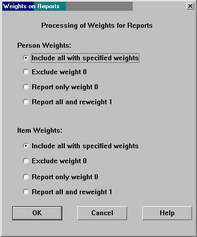There are circumstances in which certain items are to be given more influence in constructing the measures than others. For instance, certain items may be considered critical to the demonstration of competence. Though WINSTEPS supports several methods, IWEIGHT= is simplest for items, and PWEIGHT= for persons. Another approach is to replicate the data for particular items. This can be done with FORMAT= without changing the data file. Items can also be rescored from say, 0-1 to 0-2, but this makes variable maps difficult to interpret.
Unweighted and Weighted analysis: unweighted data is preferable for calibrating the Rasch items. This is because each observation is modeled to contribute one unit of independent statistical information. The effect of weighting is to distort the distribution of independent statistical information in the data. A practical approach is:
Step 1. Analyze the data without weighting. Investigate misfit, construct validity, etc.
Step 2. Weight the items. Compare the item calibrations with weighted and unweighted data to identify where there are discrepancies.
Standard errors and fit statistics: The weights applied to items or persons are used in computing the measure estimates, standard errors and fit statistics. When using significance tests with weighting, normalize the weights so that the total amount of independent statistical information in the data is not over- or under-inflated, i.e., when using PWEIGHT= with an observed sample size of N, multiply all PWEIGHT= values by N / (sum of all weights).
The standard is weights = 1.
When an item or person is weighted as 2, then the estimation acts as though that item or person appears twice in the data file.
When an item or person is weighted as 0, then that person does not influence the estimates, standard errors or fit statistics of other persons and items, but does have measure, standard error and fit statistics computed on all observations for itself. This is useful for evaluating pilot or off-dimensional items, or measuring idiosyncratic persons.
Estimation with weighting
Observation = Xni
Expected value (computed using the Rasch model) = Eni
Accumulated raw score = Accumulated raw score = Xni * IWEIGHT * PWEIGHT
Accumulated expected score = Accumulated expected score = Eni * IWEIGHT * PWEIGHT
Accumulated marginal count for item = Accumulated marginal count for item + IWEIGHT * PWEIGHT
Accumulated marginal count for person = Accumulated marginal count for person + IWEIGHT * PWEIGHT
Special rules apply when IWEIGHT=0 or PWEIGHT=0.
IWEIGHT=0 the item totals are incremented by PWEIGHT. The person totals are not incremented.
PWEIGHT=0 the person totals are incremented by IWEIGHT. The item totals are not incremented.
JMLE Estimation Accumulated expected score (for each person and each item) = Accumulated raw score (for each person and each item).
Weight Selection for Tables 23 and 24: On the output tables menu, these are the options for persons and/or items. When IWEIGHT= or PWEIGHT= are used in estimation, reports can be adjusted to reflect those weights or not. Weights of zero are useful for pilot items, variant items or persons with unusual characteristics. These can be reported exclusively or excluded from reports.
(1) all items or persons are reported, with their weights (the standard). Tables 23 and 24 are computed as though all weights are 1.
(2) items or persons with a weight of 0 are excluded from the reporting. Tables 23 and 24 are computed as though all weights are 1, but zero weights are omitted.
(3) only items or persons with a weight of 0 are reported. Tables 23 and 24 are computed only from items or persons with a weight of 0.
(4) all items or persons are reported as though they have a weight of 1.
